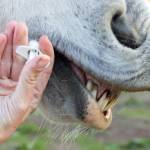Tapeworms Cause Health Problems in Horses

Tapeworms can play a significant part in several types of colic and other dangerous conditions of the equine digestive tract. Tapeworms attach to the intestinal wall, creating irritation and inflammation.
Anoplocephala perfoliata is the type of tapeworm most commonly found in horses. A favorite area of attachment for A. perfoliata is the ileocecal junction, the site where the small intestine joins the large intestine, and the inch-long tapeworms may be found in large numbers at this location.
The two other equine tapeworm species, one smaller and one much larger, favor different sections of the digestive tract. Paranoplocephala mamillana lives in the stomach and small intestine. Anoplocephala magna, which occasionally grows to a length of 30 inches, is also found in the stomach and small intestine.
Impaction colic especially ileal impaction, is a problem that has been linked to the presence of tapeworms. The worms also seem to play a role in spasmodic colic, where more than 20% of cases are associated with infestation.
Intussusception, a condition in which part of the intestine prolapses inside another section, is frequently caused by tapeworms. This serious problem often requires a surgical procedure to save the horse’s life.
Deworming products containing praziquantel are effective in removing up to 99% of equine tapeworms. A double dose of pyrantel pamoate dewormer is also effective against tapeworms. In horses with an extremely high parasite load, use of a dewormer could possibly lead to digestive tract problems due to the physical mass of dead worms and the toxins they release. Owners should read and follow usage instructions provided by the manufacturer and should address specific questions to a veterinarian.








